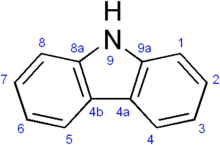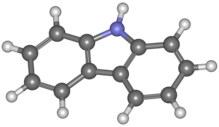
| |

| |

| |
| Names | |
|---|---|
|
Preferred IUPAC name
9H-Carbazole
[1] | |
| Other names
9-azafluorene
dibenzopyrrole diphenylenimine diphenyleneimide USAF EK-600 | |
| Identifiers | |
3D model (
JSmol)
|
|
| 3956 | |
| ChEBI | |
| ChEMBL | |
| ChemSpider | |
| DrugBank | |
| ECHA InfoCard | 100.001.542 |
| EC Number |
|
| 102490 | |
| KEGG | |
PubChem
CID
|
|
| RTECS number |
|
| UNII | |
CompTox Dashboard (
EPA)
|
|
| |
| |
| Properties | |
| C12H9N | |
| Molar mass | 167.211 g·mol−1 |
| Density | 1.301 g cm−3 |
| Melting point | 246.3 °C (475.3 °F; 519.5 K) [2] |
| Boiling point | 354.69 °C (670.44 °F; 627.84 K) [2] |
| −117.4 × 10−6 cm3 mol−1 | |
| Hazards | |
| GHS labelling: | |


| |
| Warning | |
| H341, H351, H400, H411, H413 | |
| P201, P202, P273, P281, P308+P313, P391, P405, P501 | |
| Flash point | 220 °C (428 °F; 493 K) [2] |
Except where otherwise noted, data are given for materials in their
standard state (at 25 °C [77 °F], 100 kPa).
| |
Carbazole is an aromatic heterocyclic organic compound. It has a tricyclic structure, consisting of two six-membered benzene rings fused on either side of a five-membered nitrogen-containing ring. The compound's structure is based on the indole structure, but in which a second benzene ring is fused onto the five-membered ring at the 2–3 position of indole (equivalent to the 9a–4a double bond in carbazole, respectively).
Carbazole is a constituent of tobacco smoke. [3]
Carl Graebe and Carl Glaser first isolated the compound from coal tar in 1872. [4]
Few carbazole production methods are economically viable, due to limited demand. During coal tar distillation, carbazole concentrates in the anthracene distillate and must be removed before anthraquinone production; that waste product is the major industial carbazole source. [4] [5] Polar compounds (e.g., ketones) selectively precipitate it from the anthracene; a more modern technique is simply selective crystallization from molten coal tar at high temperature [4] or low pressure (70 mmHg). [6]
A classic laboratory organic synthesis for carbazole is the Borsche–Drechsel cyclization. [7] [8]

In the first step, phenylhydrazine is condensed with cyclohexanone to the corresponding imine. The second step is a hydrochloric acid-catalyzed rearrangement reaction and ring-closing reaction to tetrahydrocarbazole. In one modification, both steps are rolled into one by carrying out the reaction in acetic acid. [9] In the third step, this compound is oxidized by red lead to carbazole itself.
Another classic is the Bucherer carbazole synthesis, which uses a naphthol and an aryl hydrazine. [10]

A third method for the synthesis of carbazole is the Graebe–Ullmann reaction.

In the first step, an N-phenyl-1,2-diaminobenzene (N-phenyl- o-phenylenediamine) is converted into a diazonium salt which instantaneously forms a 1,2,3-triazole. The triazole is unstable and at elevated temperatures, nitrogen is released and the carbazole is formed. [11] [12]

Diphenylamine derivatives, being electron rich, naturally oxidize to carbazoles when heated in air. [13] A similar reaction is the Mallory reaction:

Substituted carbazoles are most easily synthesized with transition metal coupling reactions. For applications that transition-metal impurities in the final product might inhibit, an alternative is nucleophilic aromatic substitution on dibenzothiophene dioxide. [14]
Carbazoles occur naturally in carbazole alkaloids. Carbazole alkaloids with unsubstituted benzene rings occur rarely. Olivacin has been found in the bark of Aspidosperma olivaceum and ellipticin in Ochrosia elliptica. [15] Some carbazole alkaloids, especially glybomin B, have been isolated from Glycosmis pentaphylla. [16]
-
Glycozoline
-
Olivacine
-
Ellipticin
-
Glybomine B
As carbazoles have a relatively rich UV-visible light spectrum, they see application as pigments [4] and photocatalysts. [17] The parent carbazole is used in Hydron Blue production [4] and aminoethylcarbazole is used in pigment violet 23 production. [18]

Carbazoles stabilize triplet emitters in certain light-emitting diodes; [4] in general, they are electron photodonors (hole acceptors). [19]
Carbazole electrochemically oxidizes to a conductive polymer, which has not achieved substantial industrial use. [20] Polyvinylcarbazole is useful in the electrical and electronic industries, and certain carbazole novolaks are extremely heat resistant. [4]
In organic chemistry, carbazole proper is also an ingredient for several bioactive molecules. The insecticide Nirosan, [4] the cocaine overdose antidote Rimcazole, and the veterinary NSAID Carprofen are all made from carbazole. The topoisomerase II inhibitor ellipticine fuses carbazole to a pyridine ring.
- ^ International Union of Pure and Applied Chemistry (2014). Nomenclature of Organic Chemistry: IUPAC Recommendations and Preferred Names 2013. The Royal Society of Chemistry. p. 212. doi: 10.1039/9781849733069. ISBN 978-0-85404-182-4.
- ^ a b c Lide, David R. (2007). CRC Handbook of Chemistry and Physics, 88th Edition. CRC Press. pp. 3–86. ISBN 978-0-8493-0488-0.
- ^ Talhout, Reinskje; Schulz, Thomas; Florek, Ewa; Van Benthem, Jan; Wester, Piet; Opperhuizen, Antoon (2011). "Hazardous Compounds in Tobacco Smoke". Int. J. Environ. Res. Public Health. 8 (12): 613–628. doi: 10.3390/ijerph8020613. PMC 3084482. PMID 21556207.
- ^
a
b
c
d
e
f
g
h Collin, Gerd; Höke, Hartmut; Talbiersky, Jörg. "Carbazole".
Ullmann's Encyclopedia of Industrial Chemistry. Weinheim: Wiley-VCH.
doi:
10.1002/14356007.a05_059.pub2.
ISBN
978-3527306732.
{{ cite encyclopedia}}: CS1 maint: multiple names: authors list ( link) - ^ Cofrancesco, A. J., "Anthraquinone", Kirk-Othmer Encyclopedia of Chemical Technology, New York: John Wiley, p. 5, doi: 10.1002/0471238961.0114200803150618.a01, ISBN 9780471238966
- ^ Betts, W. D., "Tar and Pitch", Kirk-Othmer Encyclopedia of Chemical Technology, New York: John Wiley, p. 5, doi: 10.1002/0471238961.20011802052020.a01, ISBN 9780471238966
- ^ W. Borsche (1908). "Ueber Tetra- und Hexahydrocarbazolverbindungen und eine neue Carbazolsynthese. (Mitbearbeitet von. A. Witte und W. Bothe.)". Justus Liebigs Ann. Chem. (in German). 359 (1–2): 49–80. doi: 10.1002/jlac.19083590103.
- ^ E. Drechsel (1888). "Ueber Elektrolyse des Phenols mit Wechselströmen". J. Prakt. Chem. (in German). 38 (1): 65–74. doi: 10.1002/prac.18880380105.
- ^ Rogers, Crosby U.; Corson, B. B. (1950). "1,2,3,4-Tetrahydrocarbazole (Carbazole, 1,2,3,4-tetrahydro-)". Organic Syntheses. 30: 90. doi: 10.15227/orgsyn.030.0090; Collected Volumes, vol. 4, p. 884.
- ^ Wang, Zerong (2010). "Bucherer Carbazole Synthesis". Comprehensive Organic Name Reactions and Reagents. pp. 549–552. doi: 10.1002/9780470638859.conrr120. ISBN 9780470638859.
- ^ Carl Graebe; Fritz Ullmann (1896). "Ueber eine neue Carbazolsynthese". Justus Liebigs Ann. Chem. (in German). 291 (1): 16–17. doi: 10.1002/jlac.18962910104.
- ^ O. Bremer (1934). "Über die Bedeutung der Graebe-Ullmannschen Carbazolsynthese und deren Übertragung auf N-substituierte Pyridino-triazole". Justus Liebigs Ann. Chem. (in German). 514 (1): 279–291. doi: 10.1002/jlac.19345140116.
- ^ Vogt, Peter F.; Gerulis, John J. "Amines, Aromatic". Ullmann's Encyclopedia of Industrial Chemistry. Vol. 2. Weinheim: Wiley-VCH. p. 703. doi: 10.1002/14356007.a02_037. ISBN 978-3527306732.
- ^ Bhanuchandra, M.; Yorimitsu Hideki. "Dibenzothiophene 5,5-dioxide". Encyclopedia of Reagents for Organic Synthesis. doi: 10.1002/047084289X.rn02046.
- ^ Eberhard Breitmaier (1997), Alkaloide, Wiesbaden: Springer Fachmedien, p. 49, ISBN 978-3-519-03542-8
-
^ Cite error: The named reference
Awas invoked but never defined (see the help page). - ^ Rizzo, Carmelo J. (2005). "N-Methylcarbazole". N -Methylcarbazole. Encyclopedia of Reagents for Organic Synthesis. doi: 10.1002/047084289X.rn00578. ISBN 0-471-93623-5.
- ^ U.S. patent 4,345,074
- ^ Ying Wang, "Photoconductive polymers", Kirk-Othmer Encyclopedia of Chemical Technology, New York: John Wiley, p. 15, doi: 10.1002/0471238961.1608152023011407.a01, ISBN 9780471238966
- ^ Naarmann, Herbert. "Polymers, Electrically conducting". Ullmann's Encyclopedia of Industrial Chemistry. Vol. 29. Weinheim: Wiley-VCH. p. 309. doi: 10.1002/14356007.a21_429. ISBN 978-3527306732.



